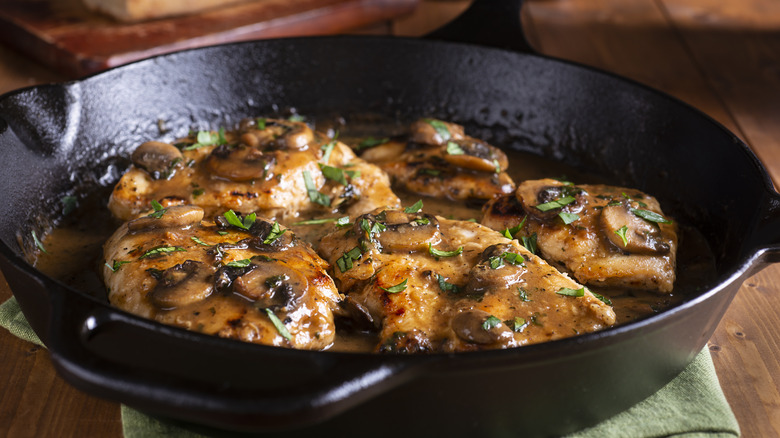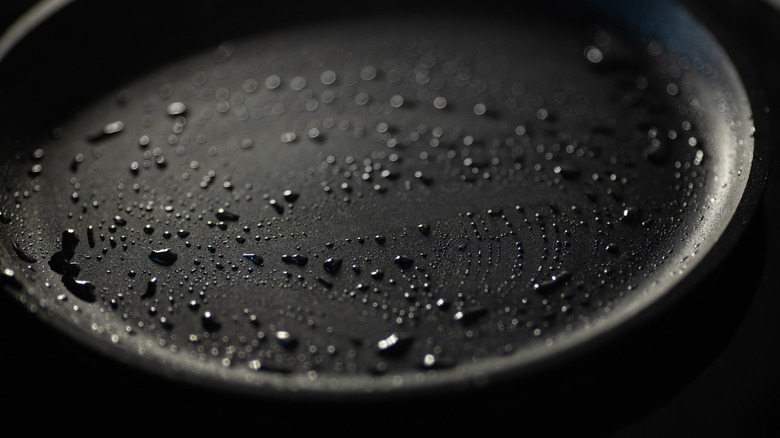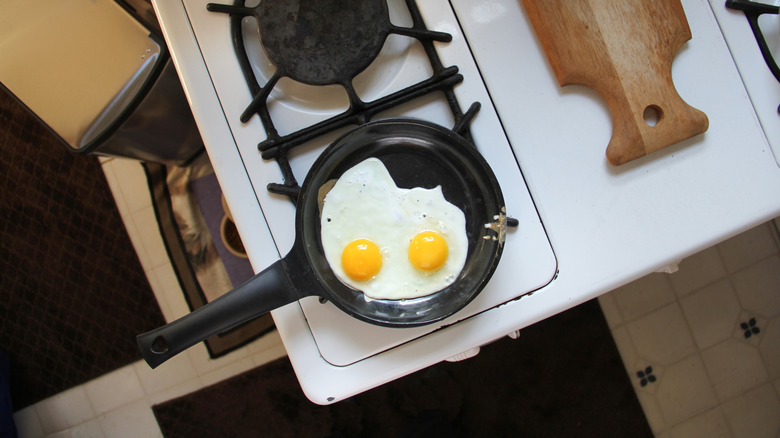Common Mistakes You're Making With Your Cast Iron Skillet — And How To Fix Them
A cast iron skillet isn't just cookware — it's a rite of passage. This kitchen workhorse can transform steaks into masterpieces and cornbread into Southern gold, but it's not exactly foolproof. Treat it wrong, and your dreams of golden, crispy perfection can turn into a sticky, smoky mess. The thing about cast iron is that it doesn't ask for much — just a bit of know-how and a dash of care. The rewards, though? A tool that gets better with age, developing a patina that tells the story of every meal you've cooked.
Don't worry if you've made mistakes. Cast iron is forgiving, and with a little effort, even the most abused pan can bounce back. Over my years working as a cook, I've seasoned and re-seasoned more skillets than I care to count, both for myself and chefs I've worked for. I've learned what works, what doesn't, and how to fix just about every cast iron blunder. From cleaning mishaps to cooking no-nos, this guide will help you avoid common pitfalls and make the most of your skillet. Ready to unlock its full potential? Let's get into it.
Not preheating the skillet properly
Think of your cast iron skillet as the diva of your cookware lineup: It needs time to warm up before it's ready to perform. Unlike stainless steel or non-stick pans, cast iron takes its time to heat evenly — and that's part of its charm. But dropping cold food into a lukewarm skillet is like showing up to a party before the host is dressed — awkward and underwhelming. You'll end up with uneven cooking, sticking, and food that's missing the coveted golden-brown exterior.
The key is patience. Set your skillet over medium heat for at least five minutes. To test its readiness, flick a few drops of water onto the surface — if they dance and evaporate instantly, it's ready to roll. For high-heat cooking like steak searing, allow the skillet to preheat longer until it's thoroughly hot. Personally, I like to let it rip until I see smoke. A hot skillet is the only way to deliver GBD to your food — Golden Brown Delicious, that is. Giving your skillet the time it needs to heat fully ensures your ingredients reach their full potential, turning good meals into great ones.
Using the wrong cooking oil
Not all oils are created equal, especially when cast iron is involved. The wrong choice can lead to burnt food, smokey kitchens, or sticky residue that's a nightmare to clean. Unclarified butter, while delicious, isn't up to the challenge of high-heat cooking — it burns quickly, leaving behind unpleasant scorches. Extra virgin olive oil, prized for its flavor, suffers the same fate, breaking down at lower temperatures and leaving your skillet coated in a tacky film.
For cooking in cast iron, the best oils have high smoke points, meaning they can handle the intense heat the skillet excels at delivering. Avocado oil, canola oil, refined peanut oil, and — my favorite — grapeseed oil are fantastic options for frying, searing, or sauteing. These oils can take the heat without burning, ensuring your food cooks evenly and your skillet stays clean. And if you're seasoning your pan? Flaxseed oil is mighty decent. For saving money, though, canola works just fine.
The oil you use also impacts flavor. While neutral oils are ideal for most tasks, experimenting with lightly flavored oils, like sesame or walnut, can add subtle depth to your dishes. However, stick to oils with appropriate heat tolerances to protect both your skillet and your food. Choosing the right oil isn't just about avoiding mishaps; it's about elevating your cooking and prolonging your skillet's life. A thoughtful choice here sets the stage for success in the kitchen every time.
Overcrowding the skillet
We've all done it: tried to squeeze one too many chicken thighs into the skillet or piled veggies to the brim. Truth is, it's lazy. And overcrowding is the fastest way to ruin a good sear. When ingredients are crammed together, heat circulation suffers, and steam builds up instead of escaping. The result? Limp food that lacks the golden-brown perfection cast iron is known for.
The solution is simple: Give your food space. Cook proteins like chicken or steak in batches, ensuring each piece has enough room to make full contact with the pan. For vegetables, arrange them in a single layer with plenty of breathing room. If you're roasting in the oven, divide large quantities between two skillets. Yes, it takes longer, but the payoff — perfectly caramelized, flavorful results — is worth every extra minute. Overcrowding doesn't just dull your food; it takes the joy out of cast iron cooking altogether. Why use it if you can't achieve that characteristic golden-brown crust?
Cooking acidic ingredients for too long
Acidic ingredients like tomatoes, citrus, or wine don't always play nice with cast iron, so you can't leave 'em alone for too long without watching. When left to simmer for extended periods of time, they can interact with the skillet, pulling iron from the surface into your food and imparting a subtle tang. Worse, prolonged exposure can weaken your seasoning, leaving the pan more prone to sticking and rusting.
That doesn't mean you have to skip your favorite tomato-based dishes. Quick-cooking recipes like a 20-minute marinara or shakshuka are perfectly fine. The key is to transfer the food promptly once it's done and avoid storing acidic leftovers in the skillet. If your seasoning looks dull after an acidic dish, give it a quick refresh to bring it back to life. By respecting your skillet's boundaries, you'll enjoy bold, tangy flavors without compromising its longevity.
Using high heat for everything
High heat is one of the perennial strengths of cast iron, but it's not the answer for every dish. Sure, it's perfect for achieving a deep sear on steak or caramelizing the edges of roasted potatoes, but for fragile items like eggs, fish, or garlic, it's overkill. Turning the heat too high often results in sticking, overcooking, or uneven results.
Instead, think of cast iron as your heat-retention champion. Medium to medium-high heat is sufficient for most tasks, while low heat works wonders for gentle simmering or sauteing. Cast iron holds onto heat long after the burner is off, so you can often start high and dial it back for a more controlled cook. Matching the heat to the dish ensures your skillet works with you, delivering flawless results every time. It's not about limiting your skillet's power — it's about knowing how to wield it wisely.
Cleaning with too much soap
For years, cast iron enthusiasts believed soap was its mortal enemy, destined to destroy the carefully built-up seasoning. The truth? Soap isn't the villain it's been made out to be — as long as you use it sparingly. A small dab won't strip the skillet's protective layer, but going overboard can start undoing all your hard work.
The best way to clean your skillet is to keep things simple. After cooking, scrape off leftover bits with a spatula or nylon scrubber. For stubborn debris, sprinkle some coarse salt in the pan, add a bit of water, and scrub gently. Still stuck? A chainmail scrubber works wonders without harming the finish. Sometimes, I even use a few handfuls of kosher salt over heat to absorb excess grease and abrase stubborn bits.
Skip the harsh detergents and heavy-duty scrubbing tools entirely — they're unnecessary and can do more harm than good. After cleaning, rinse with hot water, towel-dry immediately, and finish with a light oil rub to maintain that beautiful, slick surface. Gentle cleaning doesn't just preserve your skillet's functionality; it keeps it ready to wow with every meal.
Soaking the skillet in water
After a messy cooking session, soaking your cast iron in water might seem like the easiest solution — but it's one of the quickest ways to ruin it. Cast iron is porous and absorbs water, making it highly susceptible to rust. Even a short soak can cause problems, leaving you with a pan that's more trouble than it's worth.
To tackle tough, stuck-on food without soaking, let heat do the work. Place your skillet over medium heat, add a splash of water, and let it simmer for a few minutes. The steam will loosen residue, making it easier to scrape away. For extra-stubborn messes, a paste of coarse salt and water or a chainmail scrubber will get the job done. If rust does appear, a vinegar soak followed by a thorough re-seasoning can bring your skillet back to life. Avoiding water altogether isn't always realistic, but skipping long soaks will keep your skillet rust-free and ready to shine.
Forgetting to dry and season after cleaning
Cleaning your cast iron skillet is just the first step in a crucial two-part process. Skipping the drying and seasoning step afterward is one of the fastest ways to invite rust into your pan's life — and once rust sets in, it's a challenge to reverse. Cast iron's porous surface means even a tiny bit of leftover moisture can seep in and start causing damage. That's why thorough drying and re-seasoning are non-negotiable.
After rinsing, towel-dry your skillet immediately, but don't stop there. Place it over low heat on the stovetop to evaporate any hidden water. This step ensures the pan is completely moisture-free. Once dry, it's time to re-season. Rub a very thin layer of oil — vegetable oil, canola oil, or flaxseed oil — over the entire surface, including the handle and the bottom. The key here is "thin." Too much oil can create a sticky, uneven surface. Use a paper towel to spread the oil evenly and remove excess.
Next, heat the skillet briefly to let the oil bond with the metal. A few minutes over low heat is enough, or you can pop it in the oven. This protects the pan from rust but also reinforces its seasoning (there's a science behind this!), helping to maintain that coveted non-stick quality. Skipping this process may save a few minutes in the moment, but the long-term impact on your skillet's performance isn't worth the trade-off. With just a little extra care, you're ensuring your pan stays in pristine condition for decades to come.
Storing cast iron with the lid on
Storing your cast iron skillet with the lid on might seem like a logical choice — it keeps dust out and looks tidy — but this seemingly harmless habit can lead to big problems. Cast iron thrives in dry environments, and covering the skillet traps moisture, even if it feels completely dry after cleaning. That hidden moisture creates the perfect breeding ground for rust, compromising the skillet's performance and appearance over time.
Beyond rust, there's another risk: weird smells. Any oil, residue, or food particles left behind can become odors sealed in with the lid, leaving you with an unpleasant surprise the next time you pull out your pan. Moisture and trapped air can also dull the seasoning, making your skillet less effective at maintaining its naturally slick surface.
Instead, let your skillet breathe. Store your cast iron skillet uncovered in a cool, dry place with plenty of airflow. If you're worried about dust, insert a clean dishcloth or paper towel into the skillet. This will not only absorb any residual moisture but also prevent debris from settling inside. If space is tight and you need to stack skillets or other cookware, add a buffer — a soft cloth or paper towel between pans prevents scratching or scraping, which can damage the seasoning.
For an extra layer of care, consider re-seasoning your skillet periodically if it's stored for long stretches without use. These small adjustments keep your pan rust-free and ready to go at a moment's notice. Proper storage may not feel like a major step, but it plays a vital role in maintaining the skillet's longevity and ensuring it stays as reliable as the day you got it.
Using It only for meat
Cast iron and steak are practically synonymous, but if that's all you're using your skillet for, you're missing out on its full potential. This pan can handle far more than searing — think golden cornbread, perfectly roasted veggies, crispy potatoes, and even decadent desserts like a gooey skillet cookie. Yes, just like BJ's Brewhouse. Treating it like a one-trick pony does your skillet (and your meals) a disservice.
The magic of cast iron lies in its versatility. Its even heat control makes cast iron ideal for everything from baking crispy-crusted or deep-dish pizzas to caramelizing fruits for cobblers. How about skillet cornbread? C'mon, you can't forget the classics. This is what cast iron was made for. And because it transitions seamlessly from stovetop to oven, it's perfect for recipes that require a little of both. Exploring new ways to use your skillet isn't just fun; it also helps build up its seasoning, making it even better over time. So go ahead — bake, fry, roast, and experiment. Your skillet can handle it.
Not re-seasoning enough
Seasoning your skillet isn't just a one-time task; it's an ongoing relationship. Over time, even the most well-maintained pan will lose some of its protective coating. This is especially true if you've cooked acidic foods or cleaned too aggressively. Ignoring the need for re-seasoning can leave your skillet sticky, uneven, or vulnerable to rust.
Re-seasoning doesn't have to be intimidating. Start with a clean, dry skillet. Rub a thin layer of oil — flaxseed oil works especially well — over every surface, inside and out. Place the skillet upside down in an oven preheated to 400 degrees Fahrenheit, with a sheet of foil underneath to catch drips. Bake it for an hour, then let it cool completely in the oven. This simple process revitalizes the seasoning, ensuring your pan stays slick, resilient, and ready for anything. Think of it as a little TLC for your most trusted kitchen companion.
Using abrasive cleaners or metal scrubbers
It's tempting to reach for heavy-duty tools like steel wool or abrasive cleaners when your skillet has stubborn residue. After all, a quick scrub with a tough cleaner seems like the easiest way to get the job done. But here's the catch: Those tools can strip away the seasoning you've painstakingly built, leaving your skillet's surface bare and vulnerable to rust. Think of your skillet's seasoning as its armor — it needs care, not brute force.
When you encounter baked-on food or sticky patches, there are better solutions that won't undo all your hard work. Start with the basics: A nylon scraper or a stiff-bristled brush is often enough to tackle residue without scratching the surface. For tougher messes, sprinkle coarse salt into the pan and add a few drops of water to create a natural, gentle abrasive. Scrub the area with a soft sponge or cloth, and rinse with hot water.
If you've really put your skillet through its paces and nothing seems to work, heat can be your ally. Add a little water to the pan and bring it to a simmer. The steam will loosen debris, making it easy to scrape off with a spatula. For particularly stubborn spots, try a chainmail scrubber — it's strong enough to handle the job but gentle enough to preserve the seasoning. By sticking to these methods, you'll avoid damaging your skillet and keep it performing at its best for years to come.
Expecting cast iron to be non-stick right away
A cast iron skillet's legendary non-stick surface isn't something it's born with — it's something it earns. Expecting a brand-new skillet to perform like a well-worn family heirloom can lead to frustration. The truth is, that glossy, non-stick patina develops over time as layers of seasoning build up, and each layer is the result of consistent use and proper care.
In the early days of using a new skillet, it's best to work with it rather than against it. Avoid cooking sticky, delicate foods like eggs or thin pancakes right out of the gate. Instead, focus on recipes that help lay the foundation for a strong seasoning. Frying bacon, browning sausage, or roasting vegetables are all great ways to leave behind the natural fats that create that smooth, non-stick finish.
If you're looking to speed up the process, consider seasoning your skillet a few extra times in the oven. After cleaning and drying the pan, rub it with a thin coat of flaxseed oil, then bake it upside down at 400 degrees Fahrenheit, just like I mentioned above. Over time, you'll notice the surface becoming slicker and more resilient.
Patience is the key here. Every meal you cook adds to the skillet's character, and before long, you'll have a pan that doesn't just rival non-stick alternatives — it surpasses them. The payoff is a tool that's as reliable as it is versatile, capable of delivering perfect results for a lifetime (or longer).













